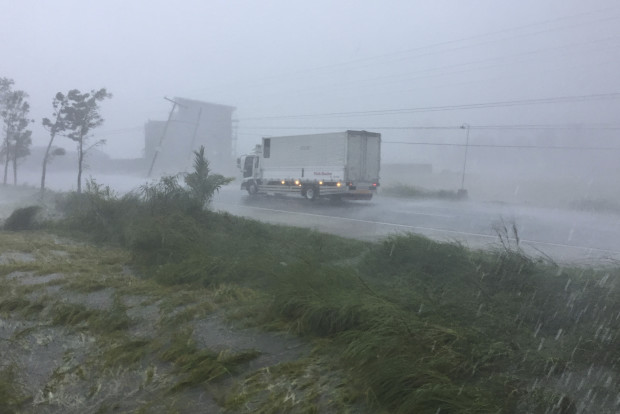
A truck drives past heavy rain and winds as Typhoon ‘Lawin’ lashes Narvacan, Ilocos Sur, on Thursday, Oct. 20, 2016. Lawin slammed into the coast of Cagayan late Wednesday with ferocious winds and rain that rekindled fears and memories from the catastrophe wrought by Typhoon Yolanda in 2013. AP
NARVACAN, Philippines — At least four people were killed after Supertyphoon “Lawin” smashed into northern Luzon with ferocious wind and rain, flooding towns and forcing thousands to flee although it slightly weakened Thursday after slamming into a mountain range on its way to the South China Sea, officials said.
Lawin’s blinding winds and rain rekindled fears and memories from the catastrophe wrought by Typhoon “Yolanda” in 2013, but there were no immediate reports of any major damage amid spotty communications and power outages in several provinces.
READ: Supertyphoon ‘Lawin’ smashes northern Luzon
Thousands of villagers were moved to emergency shelters as the typhoon approached.
Two construction workers died when a landslide buried their shanty in La Trinidad town in the mountain province of Benguet, officials said, while two villagers drowned in floodwaters in Ifugao province, near Benguet.
“We can’t go out because the wind is so intense, trees are being forced down,” Councilor Elisa Arugay told dzMM radio late Wednesday from Barangay Camasi in Cagayan.
The typhoon slammed onto shore in Cagayan late Wednesday, and lashed the mountainous province of Apayao at dawn with slightly weaker sustained winds of 205 kilometers per hour and gusts of 285 kph (176 mph). It was blowing northwestward at 25 kph toward the tobacco-growing Ilocos Norte, the last province before it exits toward the South China Sea, according to forecasters.
In Narvacan, Ilocos Sur, ricefields resembled a brown lake under waist-high floodwaters. Despite the still-strong wind and rain, government workers have started clearing roads blocked with toppled trees and all kinds of debris.
“We can’t go out because the wind is so intense, trees are being forced down,” Councilor Elisa Arugay told dzMM radio late Wednesday from Barangay Camasi in Cagayan.
Officials were concerned because the powerful typhoon struck at night and was expected to hit towns and cities amid power outages.
READ: Lawin’ rekindles fearsome memories of ‘Yolanda’ as it makes landfall
The government’s weather agency lowered the storm warning level to four, down from the highest level of five.
Many of the provinces hit by the storm were still recovering from a powerful typhoon that killed two people and displaced tens of thousands of villagers last weekend.
President Rodrigo Duterte, on an official visit to China, urged people in the typhoon’s path to heed orders by disaster agencies, including abandoning coastal communities prone to storm surges. Duterte is on a state visit to China and is to fly home Friday.
“We only pray that we be spared destruction such as in the previous past which brought agony and suffering to our people, but we are ready,” Duterte told a news conference.
“We only pray that we be spared destruction such as in the previous past which brought agony and suffering to our people, but we are ready,” Duterte told a news conference.
About 20 typhoons and storms lash the Philippines each year, adding to the many burdens in a country that is also threatened by earthquakes and volcanic eruptions and considered one of the world’s most disaster-prone nations.
In November 2013, Yolanda struck the Visayas with ferocious power, leaving more than 7,300 people dead and displacing more than 5 million others after leveling entire villages. CBB